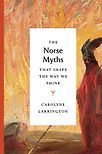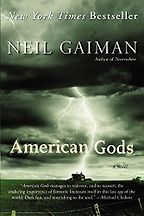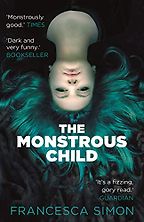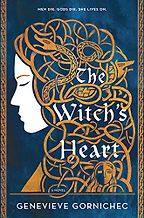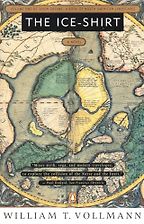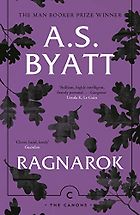In picking the best Norse mythology books you have chosen five novels. Are you particularly interested in modern re-imaginings of the Norse myths?
I chose novels because nonfiction books that deal with Norse mythology all tend to say the same thing, whereas the fictional material is much more diverse. If you want a standard retelling of the Norse myths, Kevin Crossley-Holland’s Norse Myths: Gods of the Vikings is one of the best. What’s been interesting me most in the last few years has been the ways in which Norse myth still — or increasingly — reverberates in contemporary culture.
Why do you think Norse myths continue to attract us? How do they speak to contemporary concerns?
Norse myth has been having a moment for two hundred years, and since the turn of the millennium in particular. I will put this down to straightforward things like the Thor movies, for example, breaking out of the Marvel comic universe into Hollywood blockbusters. Game of Thrones has got something to do with it as well, that fundamental myth of ice and fire that underpins George R. R. Martin’s books, which is very much the way the world is going to end in Old Norse mythology. But I think it also has to do with the unique thing about Norse myths: it’s a mythology in which the gods are going to die. They know that they’re doomed, and there’s nothing they can do about it, though Odin runs around trying to find alternative narratives, trying to find ways of staving off Ragnarok or circumventing the fate of the gods.
I think that speaks to us very much at the moment, that we’re living in a world which maybe is doomed, or at least which is facing severe difficulties, and we really have to exercise ingenuity to find a way out of it. So it’s a rather gloomy reason, I think, for why Norse myth is speaking to us. It does end in a huge conflagration and the end of the world, but at the same time there is hope, because afterwards the world comes back. It’s a clean, green, beautiful place, and maybe the whole cycle doesn’t have to repeat itself. The myths suggest everything has to go in order to start over, but I still have hope that even if we have got that terrible warning of climate catastrophe hovering over us, we can stave off Ragnarok and make the world into a better place.
How do the Norse myths differ from other European myths?
One of the striking things about Norse myth is that the gods are mostly not very interested in humans. Unlike the Greek myths, for example — where the gods are always turning up, interfering in battle and questioning what’s going on in a kingdom — in Norse myth the gods are mainly getting on with things amongst themselves or contending against the giants and their various encroachments on what the gods see as their territory. So that’s something that the novelists have had to take up, how to bring the myths into the human world and make the gods speak to humans within the stories in a way that also speaks to readers today.
Let’s talk about your first book pick, the multi-award-winning American Gods by Neil Gaiman, which has been turned into a TV series.
The premise of American Gods is that, as the various groups from Europe and other parts of the world migrated to the North American landmass, they took their gods with them. Gaiman proposes that there were earlier voyages which aren’t recorded in the sagas, in which the Norse gods made their way to North America and stayed there. There are lots of other gods as well, Egyptian gods and Indian gods all operating through the novel. But it’s the Norse gods who are of interest, because the form of Odin that we have — a con man called Mr. Wednesday — has a plan which he wants to put into action. He seeks out Shadow, a hard-living, hard-fighting man who has been in prison, with a mission for him. We also have Loki in the novel, where he styles himself as Mr. World. It turns out that Odin and Loki, between them, are unhappy about the way that the gods are losing influence in the modern world. The old gods are losing ground to the new gods, who are the gods of TV, of media, of technology, of planes, of automobiles… the gods of modernity. So the old gods have a plan to create a huge battle in the middle of Tennessee where a lot of blood will be shed, and it’s this blood of warfare that gives Odin his power.
It’s a novel which makes a lot of play with themes from Norse mythology, particularly the sacrificial myth of Baldur, but also taking up a lot of details directly from the Norse myth that you recognise as you go along, because Gaiman knows a huge amount about Norse mythology.
One of the interesting things about Gaiman’s novel is the way in which he picks up on the idea of America as the American dream: the place where everyone can come, where everyone can bring their gods, where they can make this new society. But the old gods linger, in a way as a kind of marker for ethnic identity that doesn’t get erased by the identity of being American.
American Gods is really two books in one. After the storyline between Shadow and Mr. Wednesday, there is a second part to the novel, a kind of thriller detective investigation as to who is murdering girls in a town in the Midwest.
Your next recommendation is Ragnarok: The End of the Gods by A. S. Byatt, who has won the Booker prize, among many other awards.
Ragnarok is quite a short novel. It is largely a retelling of the Norse myths, ending with Ragnarok, but it’s also interwoven with Byatt’s memories of herself. She talks about a little girl who she calls “the thin child”, but it’s clearly the young Antonia living with her mother in the countryside during the Second World War while her father is away fighting. She reads a version of the Norse myths written by the German professor Wilhelm Wägner, whose work was one of the standard children’s accounts of Norse myths. She retells and comments on these myths and describes the creation of the universe as we have it from Snorri Sturluson’s Prose Edda. But she also invents a kind of underwater version of the World Tree, and she talks quite a lot about Loki, who is the figure of all the gods who she likes best. There’s a wonderful line in which Loki is talking to his daughter, who is the world serpent, the great monster that lives in the ocean. Loki says of the other gods: “They don’t study. They hammer and slash. But I study, I know”. Byatt picks out exactly this quality in Loki as to why she’s attracted to him. He’s the thinker, the god who makes things happen. He’s the one who precipitates so many of the stories, and for someone who’s going to grow up to be a storyteller, that’s what she really likes about him.
Byatt unravels the myth. She has the world serpent going through the ocean, eating everything as a very destructive force, figuring the way in which the seas have been degraded. She ends with the end of Ragnarok, there’s no rebirth in her story. All you’re left with is a kind of black, oily slick on the sea, and that’s the end of everything.
But then her father, whom she thought she would probably never see again, whom she thought would die like Baldur as a sacrifice, comes home and is very cheerful. Real life, as opposed to mythic life, starts again. But in a wonderfully observed moment, she mentions that an ash sapling, which figures the World Tree, is growing by the shed in their garden. Her father thinks it will destroy the shed, and he takes an axe and chops it down. So there’s a sense in which that mythic delight that she was taking in these stories as a child is being crushed by the family order being restored again. There’s a lot of Byatt’s reflection on her own progress as a writer, I think, in this very short book.
I liked her description of Loki as disorder to Odin’s order, not so much good or evil as amused and dangerous.
I think there Byatt picks up on what has happened to Loki in popular culture over the last forty years. When I was a child and read children’s versions of Norse myth, Loki was bad, and that was quite straightforward. Yes, he was a bit mischievous, but he was always working for the wrong side. But increasingly Loki has become the charmer, the bad boy, the misunderstood guy. He has a lone wolf aura to him. He goes his own way and if the gods don’t like it, well, too bad. I think that the kind of independence that Loki represents is something that has made him much more attractive.
Let’s move on to your third book, The Monstrous Child, which is aimed at young adults. It is written by Francesca Simon, who is probably best known for her hugely popular Horrid Henry books for kids.
This is the third book that Francesca Simon has written about Norse myth. The Sleeping Army and The Lost Gods are for younger children. They are comic and funny and everything turns out well. In The Monstrous Child, Simon is writing for older children, with quite adult themes. She is telling the story of Hel, who is Loki’s child who is born half normal-looking and half corpse. I had always imagined that this was a split that went right down the middle, but for Simon the split is a normal upper half while Hel’s lower half is a decaying mass, rather like seaweed. She’s a happy child living with disability, but the gods decide she must go, just like Loki’s other children who are prophesied to be a danger to the gods, the wolf and the serpent. So Hel is thrown down into the world of the dead, where she must now rule, and she’s horrified and miserable. She’s a normal adolescent girl, but she has no friends. Eventually, she makes a kind of home for herself, and she makes friends with the giantess who guards the bridge into the underworld. When Baldur dies, he comes down into the world of the dead and Hel is overjoyed. He was always nice to her when she was in Asgard, and she’s had this huge crush on him, and now she’s got him. But then his wife Nanna follows and Hel realises that, in fact, Baldur loves Nanna and there’s no romantic possibility.
Ragnarok eventually takes place and the world is destroyed. At the end of it, there’s nothing left but Hel, and the world is beginning again above her. She finds that she’s able to get up into this new world and start over, creating humanity again. So it’s a wonderfully affirming story about how a child lives through the turbulence of adolescence and comes to the end of it. We don’t need the gods anymore; it’s now the time for humans. We won’t have that sort of duplicity, that scheming, that endless back and forth between the gods and the giants. It’s just humans, who now have a chance to make a better world.
This is a dark and funny young adult novel. Many of the themes that Hel struggles with will resonate with young people: her dysfunctional family, feelings of exclusion, loneliness and unrequited love, her pride and thoughts of vengeance, body image and depression.
Francesca Simon and the composer Gavin Higgins made an opera out of The Monstrous Child, which was on at the Royal Opera House and it was a wonderfully staged thing. It was brilliantly imagined and worked really well as an opera.
Next up is The Witch’s Heart by Genevieve Gornichec. Thanks for introducing it to me, I was amazed that it was a debut novel.
Yes, The Witch’s Heart is a really accomplished piece of work. In it, Genevieve Gornichec identifies quite a few of the giantess figures in Old Norse myth as a single person. This person is Angrboda, who is the mother of Loki’s children, the monstrous children: the wolf, the serpent and Hel. She is in a feud with Odin, because she has the knowledge of a particular kind of magic called seid. Odin has killed her and thrown her burnt heart out into the wasteland, but she has regenerated and is now living far away from the gods in a cave. Loki comes to find her, and she feels that Loki is the one for her. But then, for political reasons, Loki has to marry one of the goddesses, and he doesn’t come round so often. He becomes a kind of deadbeat dad, and partly because of the gods’ enmity with Loki and partly because of the threats of the prophecy, the gods come and take her children away.
Angrboda also meets Skadi, whose father was a giant who has been killed by the gods. Skadi is organising a kind of resistance movement among the giants, against the gods. By the end of the novel, you’re kind of rooting for the giants to overthrow the gods and get rid of them because they are so self-seeking, so tyrannical, so lacking in any kind of moral fibre. The idea, again, of the gods being wiped out by Ragnarok and the world starting again without them is one that seems quite compelling. The world of the gods mirrors our own world in some ways, and we need to start over in a cleaner, greener, better kind of place.
I enjoy this trend we have had in recent years of retelling well-known stories from the perspective of a minor character, it has brought us some great stories.
Every Greek mythological heroine has had her own retelling now, pretty well, but not so much the Old Norse mythology. I’ve recently read The Valkyrie by Kate Heartfield, which tells the story of Gudrun and Brynhild in a way that mixes history and mythology, and that was interesting.
We have come to your final Norse mythology book pick, The Ice-Shirt by award-winning author William T. Vollmann. Tell me about it, please.
William T. Vollmann, who wrote this book in 1990, planned to write a seven-novel series exploring the history of North America through mythological and historical themes, but I don’t think they were all written. The Ice-Shirt is a remarkable book because it blends Norse mythological history and the story of the settlement of North America from Greenland by Scandinavians, particularly focusing on a woman called Freydis, who is the illegitimate daughter of Erik the Red. She is contrasted in the novel with Gudrid, who is the wife of the main settler, Thorfinn Karlsefni. Gudrid is a virtuous, kind, clever, likeable woman, while Freydis has already trekked to the north of Greenland and pledged her allegiance to a demonic power who lives there. He’s an embodiment of the biggest mountain in Greenland, the power of ice, the power of the freezing cold which strangles all kinds of fertility.
When Freydis goes to Vinland, she sees it as her mission to bring that cold with her, to destroy the paradise that is North America, where the climate is always temperate, where there is food everywhere, animals, plants, the vines for which Vinland is named. There, she finds the Native American figure of evil. Vollman makes use of three different mythologies: the Greenlandic Inuit mythology, Norse mythology, and Mi’kmaq belief, which is the Native American group who were living there. Freydis triumphs by bringing the cold to North America, the settlement fails for various reasons, and she goes home again and lives in Greenland with nothing to show for anything. Gudrid returns to Iceland and has many descendants and a much better future.
This is all interspersed with Vollmann’s travel diary of visiting Iceland, Greenland, Baffin Island and Newfoundland in the summer of 1987 and talking about the ways in which he interacts with the various people still living there. Vollmann yokes together a grand mythological retelling of various myths across the pan-Arctic world, plus the history of the failed settlement, plus his own experiences of what it’s like to be in those regions now. The whole thing is mesmerising, in the way he switches between material that he takes from the historical or quasi-historical Norse sagas and his vision of the underworld, which is absolutely terrifying when Freydis goes into it, and also the ice and glaciers of the real world.
Even though Freydis can’t quite see what it is that she’s letting herself in for, there’s a sense that the spirit of cold and darkness is not evil. It’s just a necessary part of existence that there will always be winter as against summer, there is always cold as against warmth, there is ice as against fire. But humans inevitably bring their own passions and selfishness. Freydis’s lust for personal wealth and power is a hugely destructive impulse, the feeling that she should get everything but everybody else should have nothing.
Talking of destructive impulses, do you sometimes feel that if the Norse gods themselves behaved more ethically things would end better for them?
Increasingly, there is a shift away from the 19th-century admiration of the Norse gods as being brave and wise and noble, the gods worshipped by our ancestors. In some of the rewriting, particularly by women, the gods are thought of as power-crazy, as tyrannical, as being ready to do anything in order to preserve their power. At least in a couple of retellings we have a psychologically well-observed process of how Loki starts off as a bit playful, maybe a bit anarchic, a free spirit who gradually — through the actions of the gods — becomes more and more alienated, until he goes over to the side of the giants. The question as to whether that would always have happened, which Norse myth seems to propose that it would, as opposed to did the gods make Loki into Loki, is one of the questions of ethics that tends to come out in some of the retellings.
How did you get into Norse mythology in the first place?
I loved reading any kind of mythology when I was a kid. Then when I was 18, I ended up going to work in Norway, in a hotel on the Sognefjord for a few months. There I met some Icelanders for the first time, and I became quite interested in Iceland as a place. I became very fond of Norway, and I went back to work there for later summers when I was a student. Once I was at university, I discovered I could study Old Norse as part of the English degree there, and I realised that it was the mythology that I had loved when I was a kid that I could now study in the original language.
Do you have any particular favourite from the Norse myths?
In Voluspa, the seeress’ prophecy, the survivors of Ragnarok, the second generation of gods, creep out from the conflagration, and they find lying in the grass the golden gaming pieces that were lost at the very beginning of the world. It is a suggestion of circularity, that everything is going to start again. In Neil Gaiman’s Norse Mythology book, he has the gods set up the gaming board and put the pieces on and they start to play exactly the same game over again, so everything is going to recur. I prefer the idea that they find what was lost and they value it and they don’t start playing the same old game again — that they’ve learned something from the experience. That moment in Voluspa is my absolute favourite.
Interview by Tuva Kahrs
May 11, 2025. Updated: May 21, 2025
Five Books aims to keep its book recommendations and interviews up to date. If you are the interviewee and would like to update your choice of books (or even just what you say about them) please email us at [email protected]
Five Books interviews are expensive to produce. If you've enjoyed this interview, please support us by donating a small amount.

